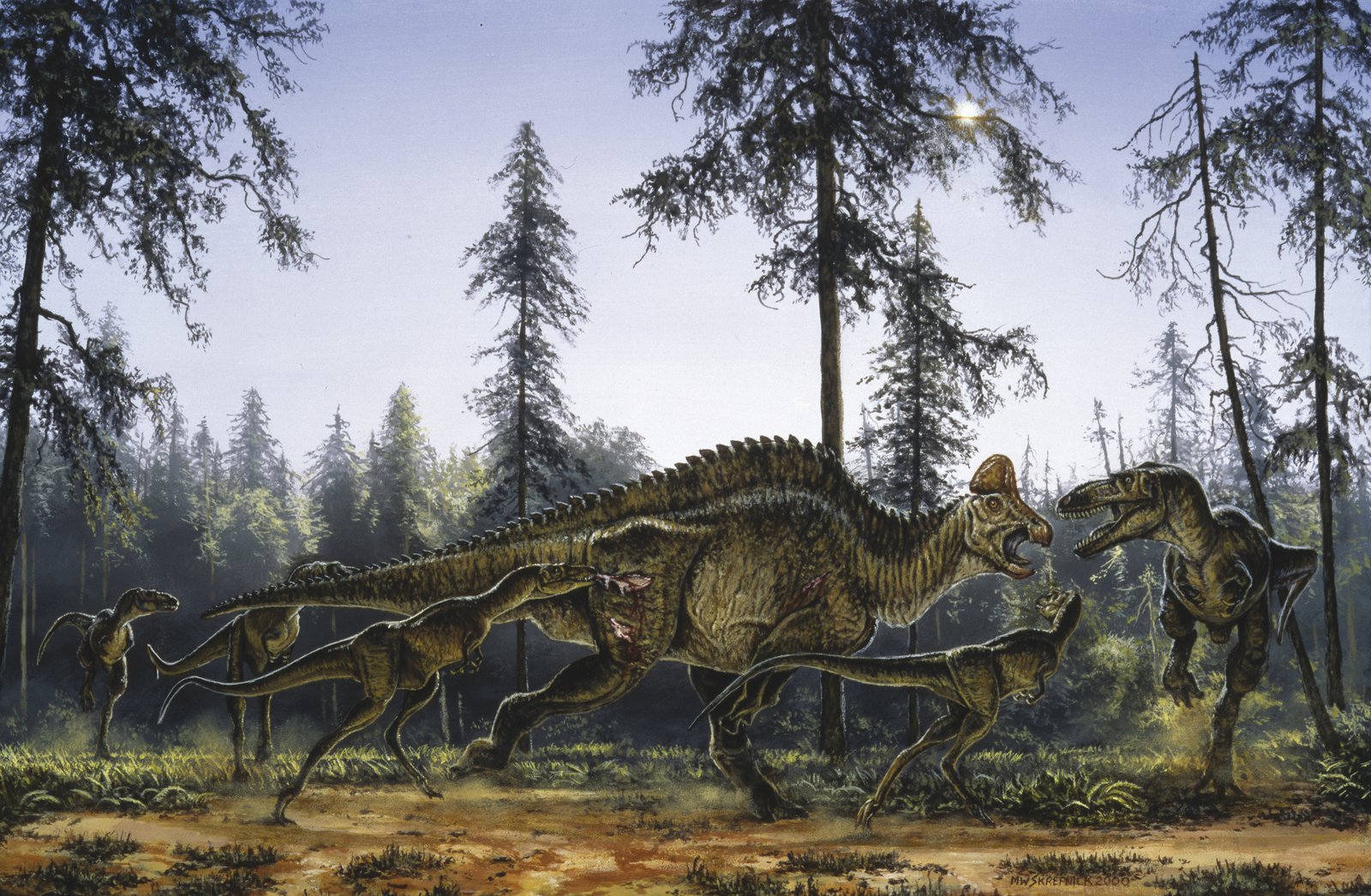Dinosaur - Albertosaurus sarcophagus
Introduction
Pronounced al-BERT-oh-SORE-us SARK-off-a-gus
Albertosaurus means ‘lizard from Alberta’ in Greek (in honour of Alberta, Canada, where many of the fossils have been discovered) and sarcophagus is Greek for ‘flesh-eating'. (A sarcophagus is a stone coffin which, when filled with lime, was believed by the ancient Greeks and Romans to 'eat' the flesh from the corpse within.)
Albertosaurus sarcophagus was the top predator of Late Cretaceous Canada, and was the most common of the large carnivores found in Alberta.

Albertosaurus attacking a hadrosaur. Some theropods like Albertosaurus (shown here attacking a hadrosaur) and Giganotosaurus possibly attacked with a 'bite and slice' technique rather than going for an outright kill. This may have helped them prey on large sauropods.
Image: Fran Dorey© Michael W Skrepnick
Identification
Albertosaurus sarcophagus was a large tyrannosaur from the Late Cretaceous of western North America. This fierce, meat-eating dinosaur was shorter and lighter than Tyrannosaurus rex and belongs in a different subfamily, Albertosaurinae, along with Gorgosaurus.
The skeleton of Albertosaurus – like other albertosaurines – differs from those of tyrannosaurines such as T. rex by its shorter, lower skull, shorter hip bones (ilia) and proportionately longer lower hind limb bones (tibiae, metatarsals and toe bones).
Like other tyrannosaurs, it walked on two powerful legs and had a large head - its skull grew to about one metre in length. It had two-fingered hands on short arms and a long tail that provided balance and the ability to turn quickly. The lower jaw of Albertosaurus had 14-16 teeth; the upper jaw had 17-19 teeth. Albertosaurus also had a distinctive short bony crest above the eyes that may have been brightly coloured and used to attract a mate.
The number of species of Albertosaurus is debated. Some scientists believe Gorgosaurus libratus should be renamed Albertosaurus libratus. A species named in 1928, A. arctunguis, has since been determined to have been a juvenile A. sarcophagus.
Habitat
Albertosaurus lived in a lush, heavily vegetated semi-tropical environment 70-74 million years ago during the Late Cretaceous Period in Canada. Most fossil remains come from a region that was once a floodplain supporting a large variety of animal life, including other dinosaurs such as hadrosaurs, ceratopsians and ornithomimids.
Distribution
The first fossils of Albertosaurus sarcophagus were found in Alberta, Canada, in 1884. All positively identified Albertosaurus sarcophagus' remains have been recovered from Alberta, but fossils have also been reported from the American states of Montana and Wyoming. The identification of these are debated, and they may be even be an unnamed species.
Feeding and diet
Albertosaurus had sharp teeth typical of modern flesh-eaters. They also had serrations on at least one tooth-edge which help cut through flesh and bone by a ‘grip and rip’ action. Their moderate body size suggests they may have been able to engage in both ambush and marathon hunting pursuits - this theory fits with their environment as it was less densely vegetated than that of similar species. They may have been able to reach speeds up to 30 km/hr when chasing prey. Their tail would have been utilised to change direction under speed.
Albertosaurus would have been able to dispatch prey of equal or greater body size. It has been suggested that they possibly attacked with a ‘bite and slice’ technique rather than going for an outright kill. This may have helped them prey on large sauropods. This theory is supported by possible evidence of pack-hunting - at one site, over 20 specimens were found together and appeared to have died at the same time.

Albertosaurus sp. tooth. Canada, Late Cretaceous, 76-74 million years ago.
Albertosaurus had sharp teeth typical of modern flesh-eaters. They also had serrations on at least one tooth-edge. Serrations help cut through flesh and bone by a ‘grip and rip’ action.
© Australian Museum
Other behaviours and adaptations
Fossils of over 30 individuals have been found, making this one of the best known and studied of the tyrannosaurs. Over 20 were recovered at one site, which suggests they lived in packs and co-operated when hunting. This treasure trove included a 2-year-old just over two metres long and weighing around 50 kilograms. The largest of the group was a very elderly 20-plus-year-old who was more than 10 metres long.
Albertosaurus, unlike T. rex, had horns on the lacrimal bones in front of the eye. These may have been coloured and used to attract a mate or for species identification.
Danger to humans
None. Humans and Albertosaurus did not coexist. Albertosaurus being extinct long (75 million years) before humans evolved.
Fossils description
The first fossils of Albertosaurus were found by 25-year-old geologist, Joseph B Tyrrell, on 9 June 1884 in the Horseshoe Canyon Formation of Red Deer River in Alberta, Canada. He was actually looking for coal.
More than 30 specimens of varying ages are known. Over the past decade, excavations of a bonebed from the lower Maastrichtian beds of the Horseshoe Canyon Formation have recovered a minimum number of 26 individuals of Albertosaurus sarcophagus.
Evolutionary relationships
Albertosaurus sarcophagus is a member of the subfamily Albertosaurinae, along with its closest relative Gorgosaurus libratus.
Although Dale Russell declared Gorgosaurus a junior synonym of Albertosaurus in 1970, most palaeontologists follow Philip Currie's 2003 work and keep the two apart in separate genera as they are no more similar than Daspletosaurus is to Tyrannosaurus. Similarities in the skull construction of Appalachiosaurus and Albertosaurus suggest they are closely related species, however, differences in these skulls suggest differences in feeding mechanisms.
Further reading
Comparison of the Functional Morphology of Appalachiosaurus and Albertosaurus.
Tamie J Jovanelly* and Lesley Lane


